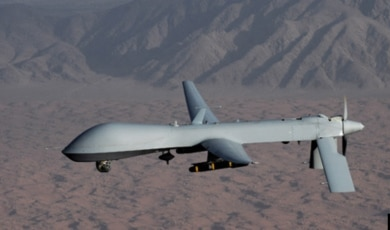
Both manned and unmanned drone technology has experienced rapid expansion in recent years, widely used in many fields, from military operations to commercial deliveries. While the benefits of this technology are undeniable, there are also concerns regarding its potential impact on a country’s air sovereignty.
The advancement of drone technology, particularly in the field of armament, has raised concerns about its accessibility to terrorist groups and individuals. The increasing use of advanced and sophisticated unmanned drones on the battlefield and for spying purposes has further compounded these concerns. The technology represents a threat to a country’s sovereignty because it can be easily purchased and used by people or terrorists.
The growing use of drones has led to an increased concern that national sovereignty could be compromised. Especially unmanned drones by its remotely operated behavior, it’s too hard to control them. Drones have the ability to enter restricted airspace undetected, posing a significant threat to national security. Recent terrorist attacks in the Red Sea region have highlighted the risks associated with this technology and its potential implications for global trade and the world economy.
Controlling the rapidly expanding use of unmanned drones may be the future homework of world leaders. According to the Joint Air Power Competence Center website, the world has entered the “second drone age.” This new era of drone warfare is defined by the global expansion of military Unmanned Aircraft Systems (UAS) and weaponized commercial drones, with both state and non-state entities battling for power in the skies above (and beyond) declared zones of conflict.
Civilians are at greater risk in this altered state of conflict. Ethical difficulties from the first drone age have been aggravated by the increasing usage of distant lethal robots, making it harder to discern between perpetrators of drone atrocities and assaults or accidents.
However, in response to these concerns, many countries have implemented strict regulations governing the use of drones. These laws often include restrictions on flight patterns, altitude limits, and the sorts of technology that drones may carry. Additionally, certain countries have established no-fly zones where drones are strictly prohibited from entering.
Also, the use of drones for military and surveillance purposes has expanded significantly and is now used by many countries and entities. Powerful nations and militant groups alike have deployed drones in strategic locations, including the Red Sea. Recognizing the vulnerability posed by the recent turmoil in the Red Sea region, Ethiopia has taken steps to protect its airspace from potential threats, including drones. The Ethiopian Air Force (ETAF) has reaffirmed its capacity and commitment to deterring any air attacks that may undermine the country’s sovereignty as it celebrates its 88th anniversary.
Yohannes Abera, the Director of Air Traffic Management at the Ethiopia Civil Aviation Authority (ECAA), stated in a recent interview with The Ethiopian Herald that the International Civil Aviation Organization (ICAO) has designated an air boundary, requiring any flying object to obtain permission before crossing it. The ECAA employs various technologies, such as Automatic Dependent Surveillance-Broadcast (ADS-B) and multilateration observational machines, to detect flying objects in Ethiopian airspace. These technologies enable the agency to establish immediate contact with the ETAF when unauthorized flying objects, whether manned or unmanned, are detected.
Whenever unauthorized or threatening manned or unmanned aircraft enter the country’s airspace, the ECAA promptly contacts the ETAF, initiating immediate collaboration between the two entities. Yohannes adds that drones weighing over 150 kg are considered aircraft, and the ECAA collaborates with the ETAF and the Information Network Security Administration (INSA) to protect air sovereignty.
While significant threats to aviation have been absent, the director highlighted the potential use of privately-owned drones for illicit purposes or as threats to border cities. The ECAA collaborates with law enforcement agencies, such as the Federal Police, ETAF, and the Ethiopian National Defense Forces, to ensure the country is protected from these potential threats at all times.
If permission is not granted, the ETAF implements interception procedures, such as directing the aircraft to land or avoid the airspace as required. Yohannes emphasized that there have been no observed high-level airspace breaches due to the presence of a strong Air Force.
Colonel Meseret Getachew, Deputy Chief of Aviation Heavy Maintenance at the ETAF, emphasized the commitment of the ETAF to national interests, extending beyond land territories.
He recalled that the ETAF successfully safeguarded maritime interests by escorting ships across the Indian Ocean and ensuring their safe arrival in port. Additionally, the air force has played a critical role in neutralizing security threats posed by terrorist and militant groups, notably al-Shabaab, with strongholds in neighboring Somalia.
Colonel Meseret added that the ETAF has taken significant steps to enhance its defense capability and protect the country’s airspace from potential adversaries. Continuous advancements in capability, management, and technological competence have been made to effectively deter potential threats.
As technology rapidly evolves, the officer stresses the need for continuous updates and adaptation to effectively counter emerging airspace threats. The ETAF’s operational methods and training align with the dynamic nature of technology, ensuring preparedness in the face of emerging threats. The ETAF possesses the capacity to predict and analyze potential threats before they materialize into attacks, thanks to sophisticated technology and meticulous analysis.
The ETAF has successfully countered numerous potential threats to Ethiopia’s air sovereignty, repelling intruders and forcing them to retreat. The Air Force’s primary focus lies in the early stages of airspace violations, aiming to swiftly predict and identify potential threats. Leveraging their electronic warfare capabilities, the ETAF can accurately assess the nature and capabilities of impending threats, allowing for timely and decisive responses, he said.
Colonel Meseret elaborated that electronic warfare (EW), which involves detecting, interpreting, controlling, or disrupting signals in the electromagnetic spectrum, plays a crucial role in protecting military assets from potential threats.
Briefly, while the expansion of drones has brought numerous benefits, it has also contributed to terrorist attacks. Regulation and robust prevention systems are necessary to mitigate the potential harm caused by drones. Ethiopia is actively building a stronger air sovereignty prevention system and has achieved an impressive audit result of 89.8 in terms of aerial safety, as conducted by the International Civil Aviation Organization (ICAO). This high level of safety indicates that Ethiopia’s measures are on par with the global average of 60.
BY EYUEL KIFLU
THE ETHIOPIAN HERALD THURSDAY 15 FEBRUARY 2024




